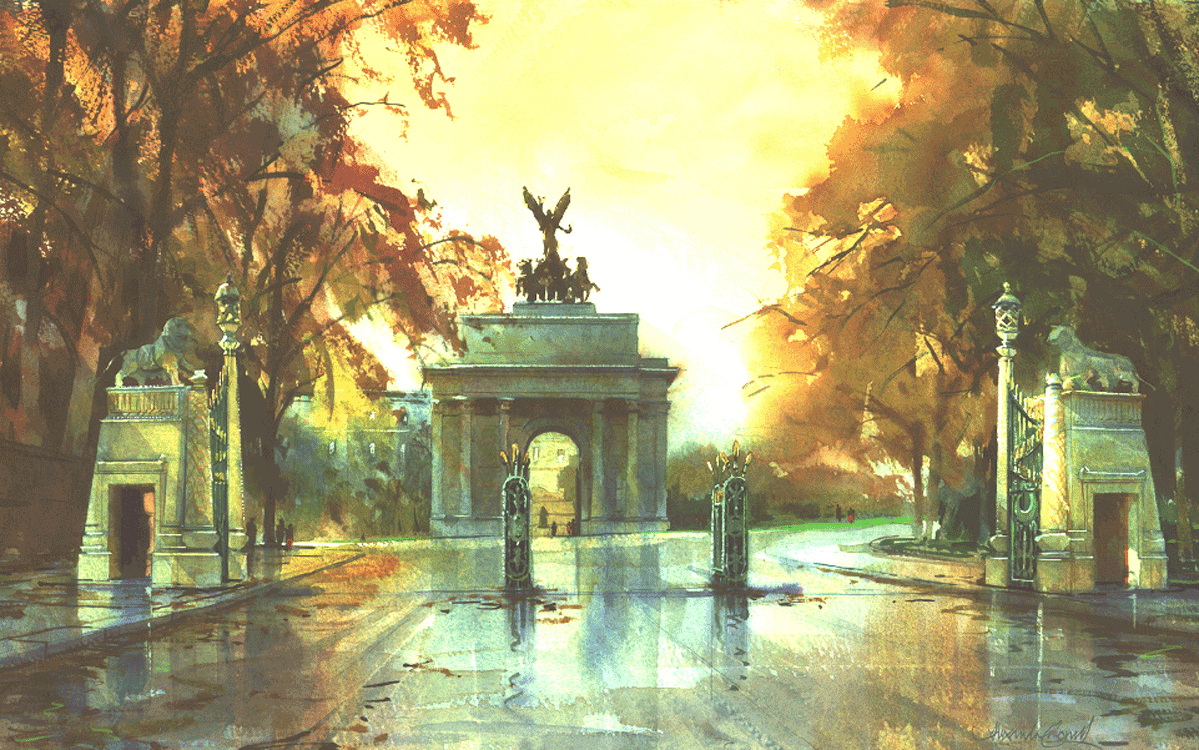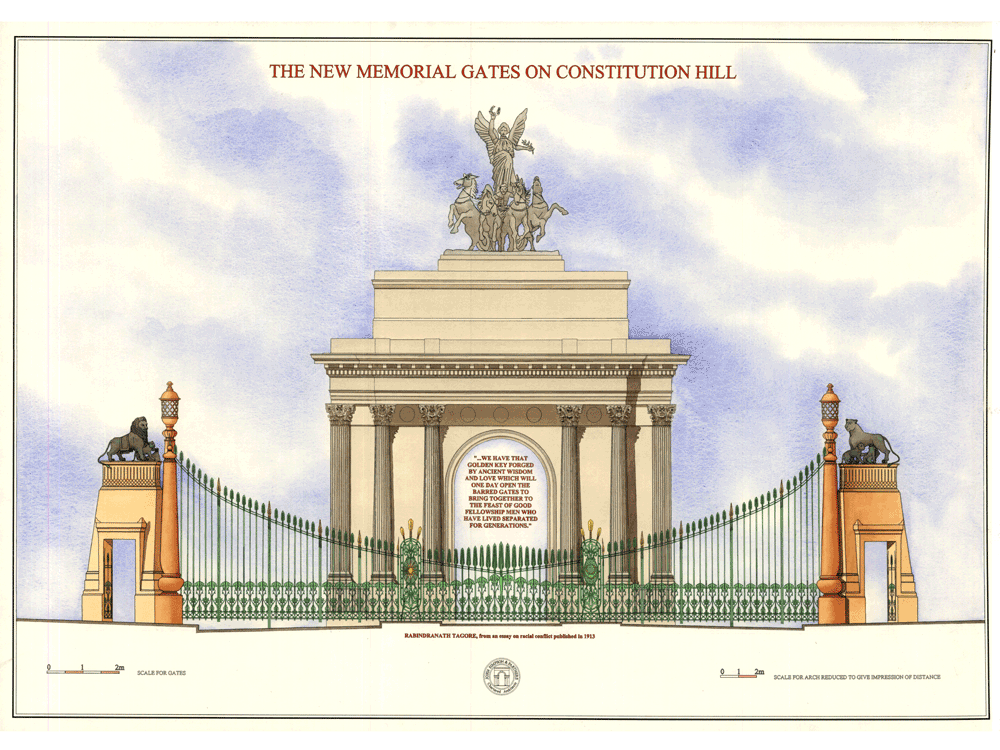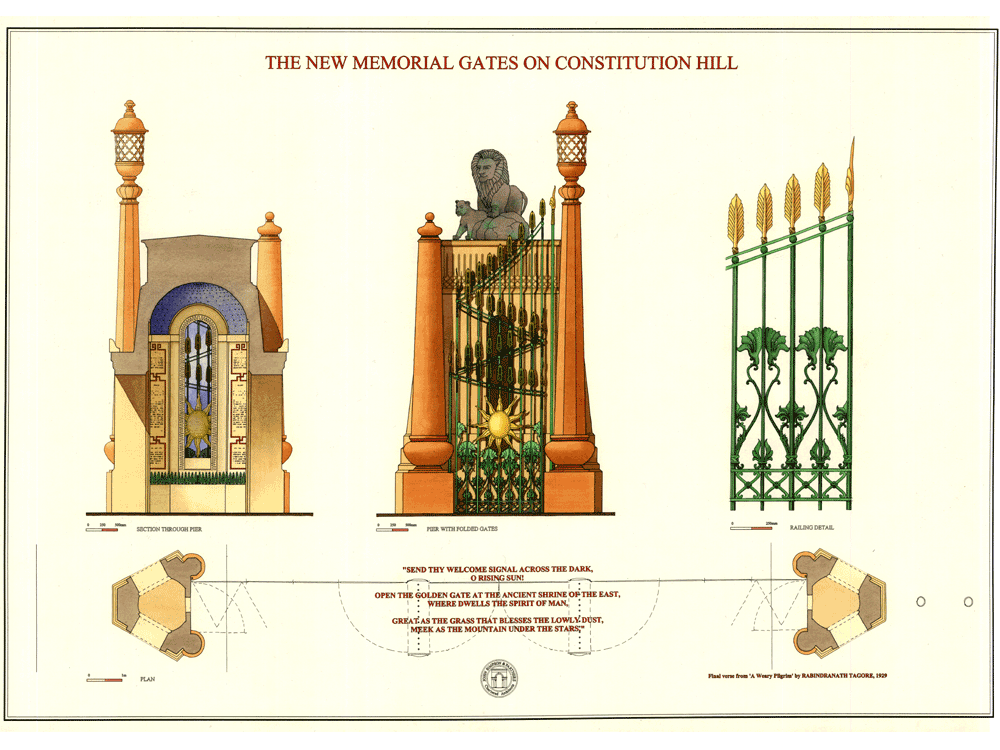
Proposal for the new memorial gates on Constitution Hill, London, United Kingdom (painting by Alexander Creswell)
THE NEW MEMORIAL GATES ONCONSTITUTION HILL
London, UK
The design for the monument commemorating the important contribution made by the communities from the Indian subcontinent, Africa and the Caribbean during both World Wars was long overdue. The commemorative gates were designed to take their rightful place alongside the other national monuments and were inspired by a passage from an essay by the eminent Indian philosopher and poet Rabindranath Tagore.
“WE HAVE THAT GOLDEN KEY
FORGED BY ANCIENT WISDOM AND LOVE
WHICH WILL ONE DAY OPEN THE BARRED GATES
TO BRING TOGETHER TO THE FEAST OF GOOD FELLOWSHIP
MEN WHO HAVE LIVED SEPARATED FOR GENERATIONS”
From an essay on racial conflict published in 1913
The location chosen for the gates was particularly poignant – opposite the great sculptural quadrega representing Peace that surmounts Constitution Arch, the only monument to Peace in London, and was envisaged as a “Gateway” to peace and reconciliation and to a “New Future”. The Gates symbolise the creation of a new society built on firm foundations of human values.
The two outer piers of the gate represent these foundations rooted to the ground each by two pillars – one each side of the folded open gate. Tagore refers to wisdom and love, one of these pillars symbolically carries a lamp representing wisdom – the accumulated knowledge and tradition handed down generation after generation and the other love, which of course begins at home with the family and extends eventually out to all human kind.

Elevation of the proposed memorial gates on Constitution Hill, London, United Kingdom (painting by Alexander Creswell)
THE NEW MEMORIAL GATES ONCONSTITUTION HILL
London, UK
The design for the monument commemorating the important contribution made by the communities from the Indian subcontinent, Africa and the Caribbean during both World Wars was long overdue. The commemorative gates were designed to take their rightful place alongside the other national monuments and were inspired by a passage from an essay by the eminent Indian philosopher and poet Rabindranath Tagore.
“WE HAVE THAT GOLDEN KEY
FORGED BY ANCIENT WISDOM AND LOVE
WHICH WILL ONE DAY OPEN THE BARRED GATES
TO BRING TOGETHER TO THE FEAST OF GOOD FELLOWSHIP
MEN WHO HAVE LIVED SEPARATED FOR GENERATIONS”
From an essay on racial conflict published in 1913
The location chosen for the gates was particularly poignant – opposite the great sculptural quadrega representing Peace that surmounts Constitution Arch, the only monument to Peace in London, and was envisaged as a “Gateway” to peace and reconciliation and to a “New Future”. The Gates symbolise the creation of a new society built on firm foundations of human values.
The two outer piers of the gate represent these foundations rooted to the ground each by two pillars – one each side of the folded open gate. Tagore refers to wisdom and love, one of these pillars symbolically carries a lamp representing wisdom – the accumulated knowledge and tradition handed down generation after generation and the other love, which of course begins at home with the family and extends eventually out to all human kind.

Details of pier and folding gates for Constitution Hill, London, United Kingdom (painting by Alexander Creswell)
THE NEW MEMORIAL GATES ONCONSTITUTION HILL
London, UK
The design for the monument commemorating the important contribution made by the communities from the Indian subcontinent, Africa and the Caribbean during both World Wars was long overdue. The commemorative gates were designed to take their rightful place alongside the other national monuments and were inspired by a passage from an essay by the eminent Indian philosopher and poet Rabindranath Tagore.
“WE HAVE THAT GOLDEN KEY
FORGED BY ANCIENT WISDOM AND LOVE
WHICH WILL ONE DAY OPEN THE BARRED GATES
TO BRING TOGETHER TO THE FEAST OF GOOD FELLOWSHIP
MEN WHO HAVE LIVED SEPARATED FOR GENERATIONS”
From an essay on racial conflict published in 1913
The location chosen for the gates was particularly poignant – opposite the great sculptural quadrega representing Peace that surmounts Constitution Arch, the only monument to Peace in London, and was envisaged as a “Gateway” to peace and reconciliation and to a “New Future”. The Gates symbolise the creation of a new society built on firm foundations of human values.
The two outer piers of the gate represent these foundations rooted to the ground each by two pillars – one each side of the folded open gate. Tagore refers to wisdom and love, one of these pillars symbolically carries a lamp representing wisdom – the accumulated knowledge and tradition handed down generation after generation and the other love, which of course begins at home with the family and extends eventually out to all human kind.